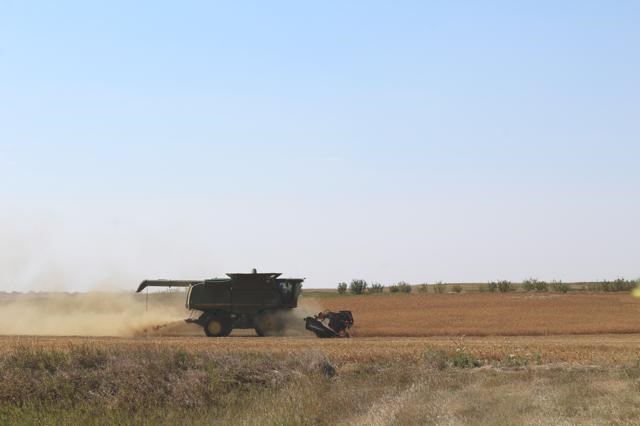The relatively warm and dry weather has allowed many producers to continue with harvest operations, reported Saskatchewan Agriculture for the week ending September 4. This year, producers across the province have an average of 45 per cent of the crop now in the bin. They also have 28 per cent of the crop swathed or ready to straight cut.
This figure is well ahead of the five-year average of 28 per cent and ten-year average of 27 per cent combined for this time of year. One year ago, a dry week allowed for 32 per cent of the crop to be combined and 38 per cent swathed or ready to straight cut. Last year, yields were estimated to be above long-term averages, with the exception of lentils.
This year, harvest progress is most advanced in the southwest region where 70 per cent of the crop is now combined. The southeast region has 60 per cent combined, the west-central region 44 percent and the east-central region 36 per cent in the bin. The northern parts of the province are just getting started with 12 per cent combined in the northeast region, while the northwest region has 18 per cent combined.
Harvesting of crops are variable and some are well ahead of others. The fall rye is 99 per cent in the bin, winter wheat is 98 per cent, lentils are 91 per cent, field peas are 90 per cent, durum is 62 per cent, mustard is 58 per cent, and barley is 51 per cent combined. Other crops are further behind. Only 38 per cent of spring wheat is in the bin, 31 per cent of the chickpeas, 27 per cent of triticale, 26 per cent of canola, 24 per cent of the oats, 16 per cent of canary seed and nine per cent of flax have now been combined.
Provincially, 49 per cent of canola and 29 per cent of the spring wheat and mustard have been swathed or ready to straight cut. Not much harvest progress has been made on soybeans which remains at eight per cent combined, similar to the previous reporting week.
The majority of the province received little to no rainfall this past week with the highest rainfall for the week of 56 mm reported in the Langenburg area. No other area received a similar amount of rainfall. The next highest amount reported was 6 mm in the Nipawin area. The Pierceland area still ranks as the highest amount of rainfall received in the province since April 1 at 543 mm.
Topsoil moisture conditions remain low. Across the province, topsoil moisture on cropland is rated as 24 per cent adequate, 42 per cent short and 34 per cent very short. Hay land and pasture topsoil moisture is rated as 19 per cent adequate, 38 per cent short and 43 per cent very short.
The majority of crop damage this past week is attributed to lack of moisture and strong winds. Producers across the province are busy combining, desiccating crops and hauling bales and grain.
In southwestern Saskatchewan, harvest continues to progress quickly with the warm and dry weather. There is now 70 per cent of the crop in the bin, up from 49 per cent last week. This is well ahead of the five-year average of 45 per cent for this time of year in the region. An additional 13 per cent is swathed or ready to straight-cut. There is 17 per cent of the southwest crop still standing, and two per cent in swath and 11 per cent ready to straight combine. This is well ahead of the provincial average of 27 per cent still standing and well ahead of the rest of the province.




